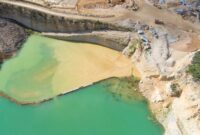Mining gold in mountainous regions has long been an attractive venture for investors seeking high returns. With modern advancements in technology and increased global demand for precious metals, gold mining has become a potentially lucrative investment. However, this opportunity comes with significant risks, which every investor should understand. This article explores the prospects of mining gold in the mountains, delves into the associated risks, and provides a comprehensive analysis for potential investors.
Investment Opportunities in Mining Gold in the Mountains
Gold remains a highly valuable resource, and its price tends to rise in times of economic uncertainty. This has drawn the attention of investors worldwide, especially those looking for long-term stability. Gold mining, particularly in mountainous areas, presents a range of investment opportunities due to the rich deposits found in such regions.
1. High Demand for Gold
Gold is universally recognized as a store of value. Its demand, both from the jewelry industry and technology sector (particularly in electronics), remains robust. Mining companies operating in mountainous areas often have access to untapped reserves, providing ample opportunities for growth. Investors looking to diversify their portfolios may find mining gold in the mountains an excellent option for achieving solid returns.
2. Geographic and Geopolitical Advantage
Mountainous regions are typically less developed, making gold deposits in these areas less exploited. Countries like Canada, Peru, and South Africa are rich in mountainous gold reserves, providing significant opportunities for investors to capitalize on untapped resources. Governments in these regions often encourage foreign investment in mining, offering tax incentives and support.
3. Technological Advancements
The mining industry has seen technological innovations that make extracting gold from mountains more efficient. Advancements in machinery and processes, such as eco-friendly mining techniques, have reduced operational costs while increasing productivity. As a result, investors in gold mining companies can benefit from higher profitability and sustainability, making mining gold in the mountains more appealing.
4. Long-Term Stability
Gold is a hedge against inflation and currency fluctuations. While other investments may lose value during economic downturns, gold typically retains or increases its worth. Investing in gold mining in the mountains provides a long-term opportunity to safeguard wealth against future market instability.
Risks of Mining Gold in the Mountains
While the potential for profit is high, mining gold in the mountains is not without its risks. Investors should carefully consider the challenges and uncertainties associated with this type of venture.
1. High Initial Investment Costs
Mining in mountainous regions requires specialized equipment and infrastructure. The costs of developing these mines can be significant, often running into millions of dollars. For individual investors or small firms, this may be a barrier to entry, as the capital needed to start operations is considerably higher than in other mining areas.
2. Environmental Impact and Regulatory Issues
Mining activities in mountainous regions can have detrimental effects on the environment. Governments and environmental organizations are increasingly focused on sustainability, imposing strict regulations that can increase costs for mining companies. Failure to comply with environmental standards can lead to hefty fines or even the shutdown of mining operations, making it a risky investment.
3. Geological and Operational Challenges
Mountains present challenging terrains, making gold mining more complex and dangerous than in flat areas. Landslides, avalanches, and unstable ground conditions can lead to accidents and operational delays. Additionally, harsh weather conditions can disrupt mining activities, increasing the overall costs and reducing the potential for profit.
4. Fluctuating Gold Prices
Although gold is considered a stable investment, its price can be volatile in the short term. Global factors such as changes in interest rates, geopolitical tensions, and economic policies can affect gold prices. Investors need to be aware that a sudden drop in gold prices can significantly impact the profitability of mining ventures.
Conclusion: Balancing Opportunities with Risks
Investing in mining gold in the mountains offers both high rewards and considerable risks. While the demand for gold and advancements in mining technology make it a promising investment, the high costs and environmental challenges should not be overlooked. Investors must weigh these factors carefully and perform thorough due diligence before committing their resources to such ventures.
For those willing to take on the risks, mining gold in the mountains could represent a unique opportunity to achieve substantial financial returns while contributing to the global supply of this precious metal. By understanding both the opportunities and risks involved, investors can make informed decisions that align with their financial goals.
FAQs
1. Is mining gold in the mountains a good investment?
Mining gold in mountainous regions can be a lucrative investment due to the rich gold deposits found in such areas. However, it is essential to consider the high costs and risks involved, such as environmental regulations and operational challenges.
2. What are the environmental concerns associated with mining gold in the mountains?
Gold mining in mountainous regions can lead to deforestation, water pollution, and habitat destruction. Governments and environmental organizations impose regulations to mitigate these impacts, but compliance can increase operational costs.
3. How much does it cost to start a gold mining operation in the mountains?
The initial costs of starting a gold mining operation in mountainous regions can be substantial, often ranging from millions to tens of millions of dollars. These costs include infrastructure development, equipment, and compliance with environmental regulations.
4. What are the technological advancements in mining gold in the mountains?
Technological innovations have made gold mining more efficient and environmentally friendly. Advances such as automated machinery, remote sensing technologies, and eco-friendly mining techniques have significantly improved productivity while reducing environmental impact.
5. How do gold price fluctuations affect mining investments?
Gold prices can be volatile in the short term, influenced by global economic factors such as interest rates, inflation, and geopolitical tensions. Investors in gold mining should be prepared for potential price fluctuations, which can impact the profitability of their ventures.




